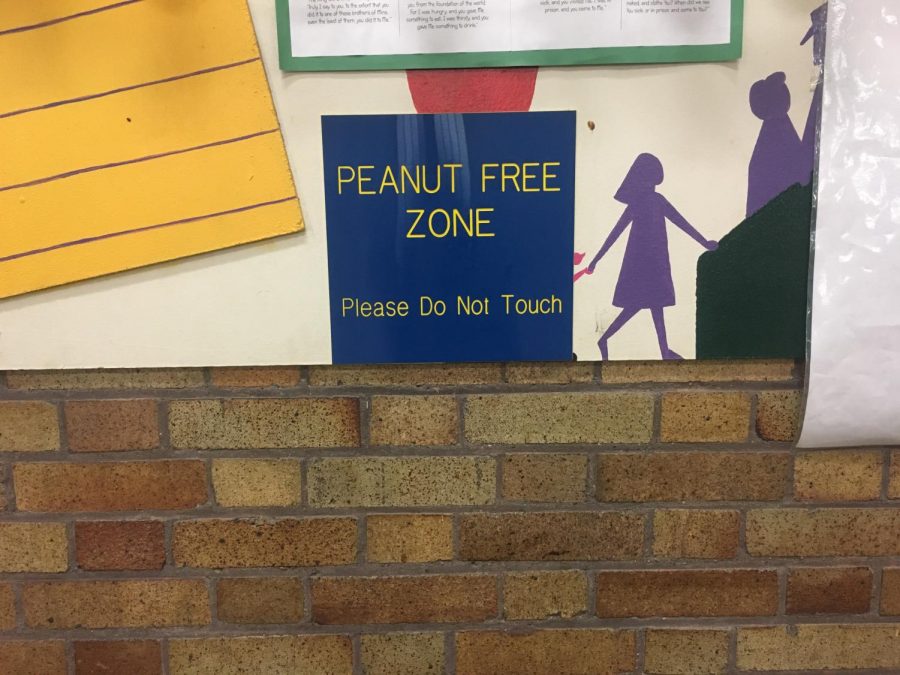What Ever Happened to the ‘No Peanut Zone’?
At St. Mary School in Hyde Park, the “Peanut Free Zone” table holds a sign informing students not to bring nuts of any kind to this table. The “Peanut Free Zone” is a place for students with mild to severe nut allergies to stay away from possible allergic reactions.
January 24, 2017
The “nut-free zone” or “no nut table” is a place where students with nut allergies can eat without the threat of having an allergic reaction. The designated area is a common feature of elementary school cafeterias. However, at WHHS this phenomenon ceases to exist. What happened to the “no nut table?”According to the National Peanut Board, about 2% of students have nut allergies.A fraction of students have nut allergies so severe that touching or smelling nut products triggers an allergic reaction. A severe allergic reaction results in “anaphylaxis,” an acute, life-threatening reaction that results in difficulty breathing, increased heart rate, and low blood pressure that causes fainting. People with severe allergies often carry an EpiPen that injects adrenaline into the bloodstream.All cafeteria foods avoid nut products in their recipes, yet most schools do not practice a complete nut-ban. Nevertheless, students can still bring nut products into the lunchroom. Therefore, many schools establish a “no nut table” to provide a safe zone for students with nut allergies of varying degrees.“One person harmed by peanuts is one too many,” states the National Peanut Board.So does Walnut Hills need a “no nut table?” The Chatterbox took the question to students of Walnut.Jack McDaniel, ‘22, is severely allergic to tree nuts. “My throat swells up and then I can’t breathe and I have an EpiPen to stop it,” he said. At McDaniel’s elementary school, Fairview-Clifton German Language School, he sat at the “no nut table” with all his friends. “It was just a circular table with a sign above that said ‘no nuts,’” McDaniel recalls. Non-allergic guests are not supposed to bring nuts to the table, but mistakes happen.“If our parents accidentally packed nuts, we’d just eat it all at the other end of the table and then wash our hands and come back,” admitted Marcus Vilski, ‘22, a friend of McDaniel. McDaniel says he did not monitor his friends’ diet then, and neither does he now.Although only a small portion of students at Walnut have nut allergies, McDaniel still likes the idea of a “no nut table” at WHHS. “I don’t know. I guess I’ve just lived with [the “no nut table”] all my life, so maybe that’s why,” he said.However, some students with nut allergies do not see the need to continue sitting at a “no nut table” in high school. Sophia Schwerin and Alexandria Nelson, ‘21, sat together at the “no nut table” at Fairview all the way from kindergarten through sixth grade. Both have nut allergies, yet Schwerin’s is more sensitive. “I can smell them, but it does not smell very pleasant, and if I touch them I might get a rash,” said Schwerin.Schwerin believes that there is just no room for a “no nut table” at WHHS. “Where would they put it?” Schwerin exclaimed. “There’s too many kids, and honestly people wouldn’t even sit at it; they’d just want to sit with their friends,” agreed Nelson.And perhaps that is why there is no nut free zone at WHHS. Students were drawn to the peanut table because of their allergies, but stayed there because of the social experience. In elementary school, students with nut allergies and their closest friends were guaranteed a place to enjoy nut-free lunches together every day. In high school, with changing friend groups and a different social climate, these students do not necessarily need a designated area for them and their friends anymore.







